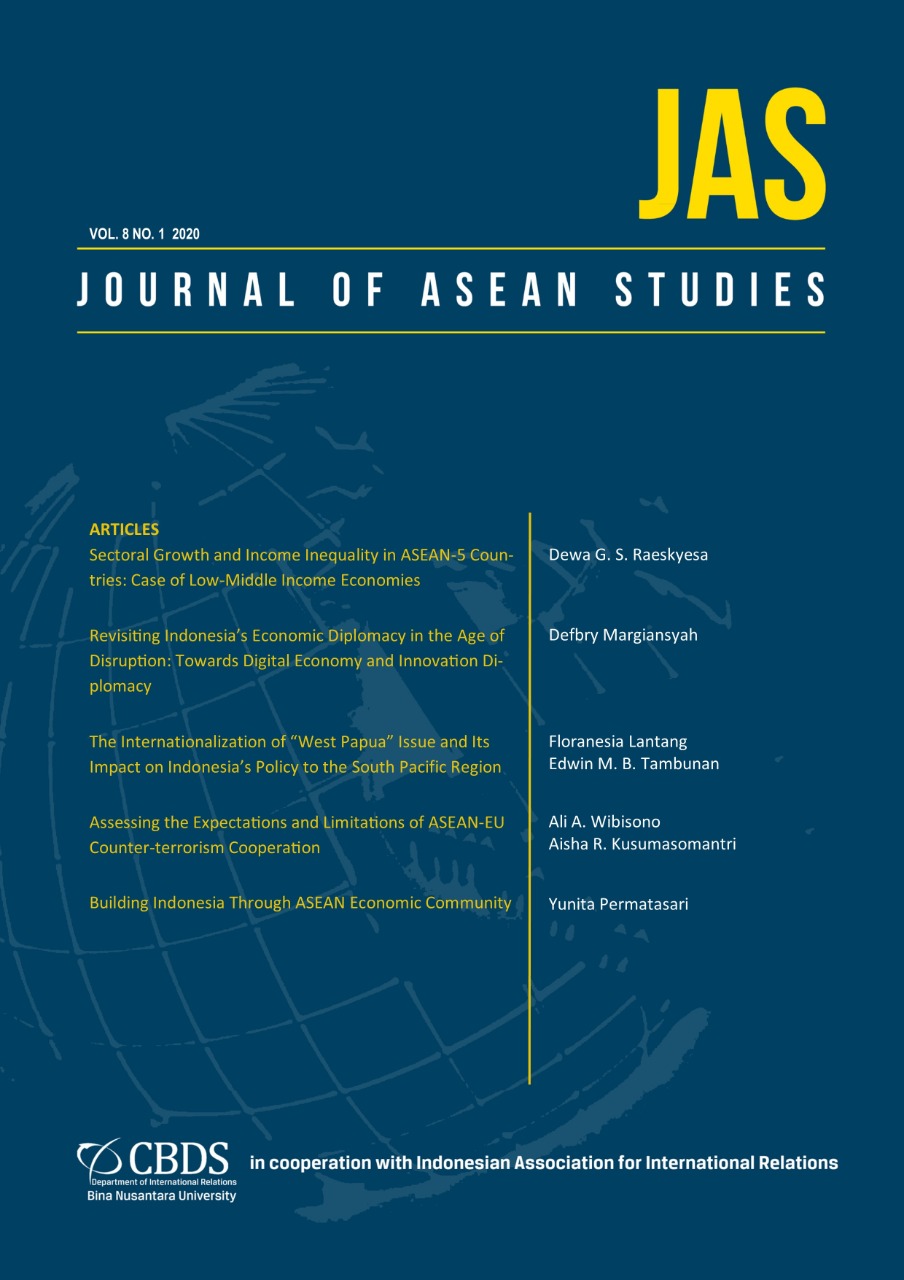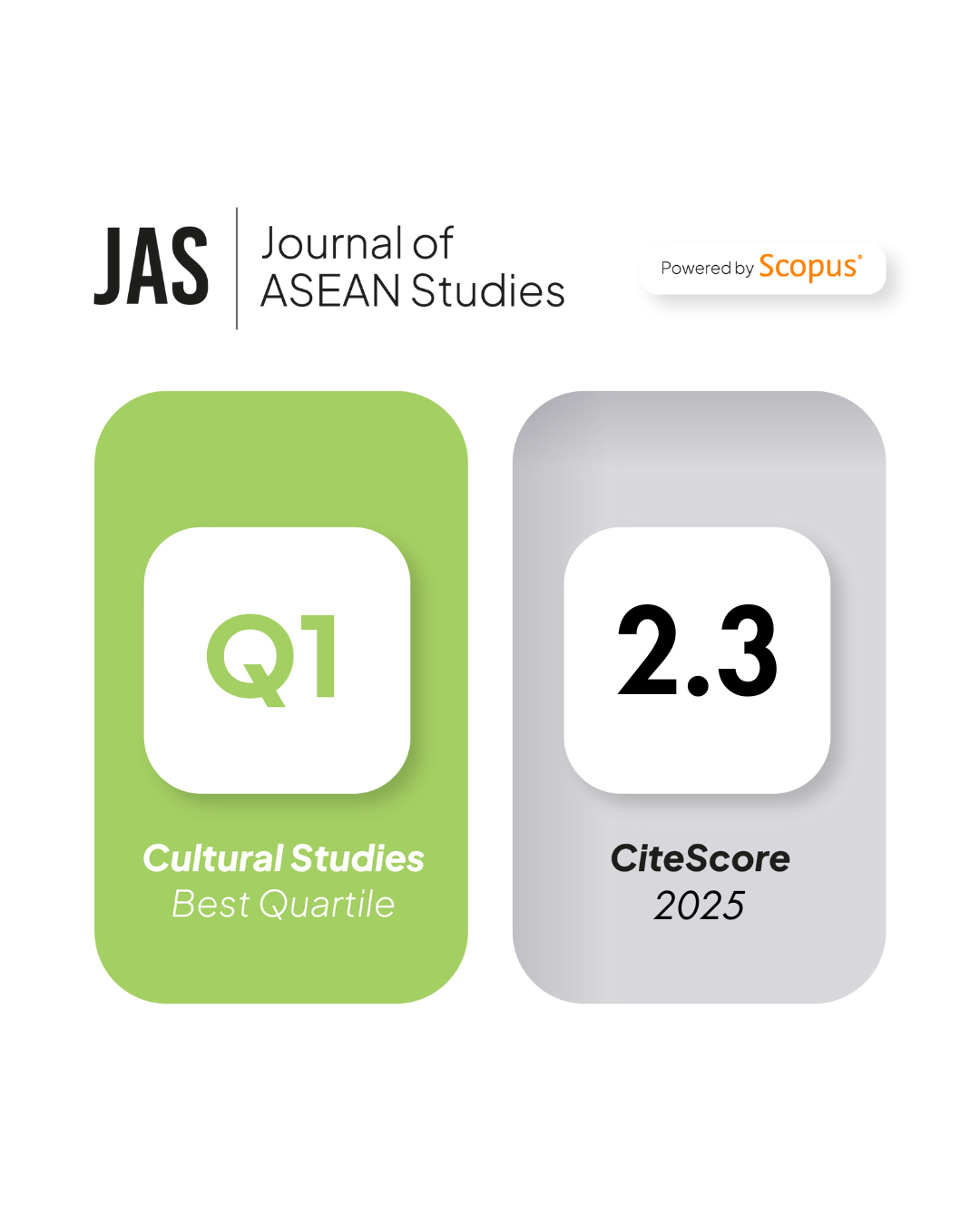Sectoral Growth and Income Inequality in ASEAN-5 Countries: Case of Low-Middle Income Economies
DOI:
https://doi.org/10.21512/jas.v8i1.6435Keywords:
ASEAN, Developing Countries, Economic DevelopmentAbstract
This paper aims to explore the relationship between growth in economic sectors, especially manufacturing, service, and agriculture, towards income inequality. Furthermore, it utilizes panel data for low-middle income ASEAN countries. The result shows that the share of agricultural sector in GDP has a significant and negative relationship with income inequality. In fact, the effect is robust for the incorporation of control variables. Therefore, it underlines the importance of agricultural sector development for reducing inequality and also for fostering ASEAN economic integration.
References
Aldaba, R. M., & Pasadilla, G. (2010). The ASEAN Services Sector and the Growth Rebalancing Model. ADBI Working Paper Series No. 246.
Alesina, A., & Rodrik, D. (1994). Distributive Politics and Economic Growth. The Quarterly Journal of Economics, 465-490.
Anderson, E., D’Orey, M., Duvendack, M., & Esposito, L. (2017). Does Government Spending Affect Income Inequality? A Meta-Regression Analysis. Journal of Economic Surveys, 961–987.
ASEAN. (2019). ASEAN Key Figures. Jakarta: ASEAN Secretariat.
Asongu, S. A., Orim, S.-M., & Nting, R. (2019). Inequality, information technology and inclusive education in sub-Saharan Africa. Technological Forecasting & Social Change, 380-389.
Barron, P., Jaffrey, S., & Varshney, A. (2014). How Large Conflicts Subside: Evidence from Indonesia. Indonesian Social Development Paper no. 18.
Basri, F., & Putra, G. (2016). Escaping the middle income trap in Indonesia; an analysis of risks, remedies and national characteristics. Jakarta: Friedrich-Ebert-Stiftung Indonesia Office.
Briones, R., & Felipe, J. (2013). Agriculture and Structural Transformation in Developing Asia: Review and Outlook. ADB Economics Working Paper Series No. 363.
Brueckner, M., Dabla-Norris, E., Gradstein, M. (2014). National Income and Its Distribution. IMF Working Paper. WP/14/101
Castelló, A., & Domenech, R. (2002). Human Capital Inequality and Economic Growth: Some New Evidence. The Economic Journal, pp. C187-C200
Chong, A., & Gradstein, M. (2007). Inequality and Institutions. The Review of Economics and Statistics, 454-465.
Cuong, N. V. (2010). Does Agriculture Help Poverty and Inequality Reduction? Evidence from Vietnam. Agricultural Economics Review.
Ding, S., Meriluoto, L., Reed, W., Tao, D., & Wu, H. (2011). The impact of agricultural technology adoption on income inequality in rural China: Evidence from southern Yunnan Province. China Economic Review, 344–356.
Dabla-Norris, E., Kochhar, K., Suphaphiphat, N., Ricka, F., Tsounta, E., (2015). Causes and Consequences of Income Inequality: A Global Perspective. IMF Staff Discussion Note. SDN/15/13
Farris, F.A. (2010). The Gini Index and Measures of Inequality. The American Mathematical Monthly, Vol. 17, No. 10, pp: 851-864
Feenstra, R., & Hanson, G. (2003). Global production sharing and rising inequality: a survey of trade and wages. In E. K. Choi, & J. Harrigan, Handbook of International Trade (pp. 146-185). Blackwell.
Forbes, K. J. (2000). A Reassessment of the Relationship between Inequality and Growth. American Economic Review, 869-887.
Fournier, J.-M., & Johansson, Ã…. (2016). The effect of the size and the mix of public spending on growth and inequality. OECD Economics Department Working Paper No. 1344.
Furceri, D., & Loungani, P. (2015). Capital Account Liberalization and Inequality. IMF Working Paper/15/243.
Gordón, I. G., & Resosudarmo, B. (2018). A sectoral growth-income inequality nexus in Indonesia. Regional Science Policy and Practice, 123–139.
Gujarati, D. N., & Porter, D. (2009). Basic Econometrics. New York: Mcgraw-Hill International Edition.
Haughton, Jonathan; Khandker, Shahidur R. (2009). Handbook on poverty and inequality (English). Washington, DC: the World Bank.
Imai, K. S., Gaiha, R., & Cheng, W. (2016). Does Agricultural Growth Reduce Inequality and Poverty in Developing Countries? RIEB Kobe University Discussion Paper Series.
Kubitza, C. Dib, J.B., Kopp, T., Krishna, V.V., Nuryartono, N., Qaim, M., Romero, M., Klasen, S. (2019). Labor savings in agriculture and inequality at different spatial scales: The expansion of oil palm in Indonesia. EFForTS Discussion Paper Series, No. 26
Menon, J. (2012). Narrowing the Development Divide in ASEAN: The Role of Policy. ADB Working Paper Series on Regional Economic Integration No. 100.
Montalvo, J., and Ravallion, M. (2010). The Pattern of Growth and Poverty Reduction in China. Journal of Comparative Economics, 38(1): 2-16.
OECD, & FAO. (2017). Agricultural Outlook 2017-2026. Paris: OECD Publishing.
Pangestu, M. E. (2009). Competitiveness towards ASEAN economic community. Journal of Indonesian Economy and Business, 22-32.
Paus, E. (2017). Escaping the middle-income trap: innovate or perish. ADBI Working Paper Series 685.
Persson, T., & Tabellini, G. (1994). Is Inequality Harmful for Growth? The American Economic Review, 600-621.
Riantika, I. B., & Utama, M. (2017). Penentuan Prioritas Pembangunan Melalui Analisis. E-Jurnal Ekonomi Pembangunan Universitas Udayana, 1185-1211.
Pratysto, T., & Panjaitan, I., (2019). Eradicating Income Inequality in Lower Middle-Income Countries. Jurnal Ekonomi Pembangunan: Kajian Masalah Ekonomi dan Pembangunan, 20 (2), 2019, 222-231.
Seers, D. (1969). The Meaning of Development. IDS Communication 44.
Siami-Namini, S. (2017). Granger Causality Between Gross Domestic Product and Economic Sectors in Developing Countries: A Panel Co-integration Approach. International Journal of Economics and Financial Issues, 53-58.
Siami-Namini, S., & Hudson, D. (2019). The impacts of sector growth and monetary policy on income inequality in developing countries. Journal of Economic Studies, 591-610.
Trapeznikova, I. (2019). Measuring income inequality, IZA World of Labor, Institute of Labor Economics (IZA), 462-462, July.
The World Bank (2003). Land policies for growth and poverty reduction. http://documents.worldbank.org/curated/en/
UNESCAP. (2018). Inequality in Asia and the pacific in the era of the 2030 agenda for sustainable development. The United Nations Economic and Social Commission for Asia and the Pacific.
World Development Indicator. https://databank.worldbank.org/source/world-development-indicators#
Xu, W., & Islam, S. (2019). What Does ASEAN Economic Community Bring to Older Workers? Examining Inequality in Old Age in Thailand’s Fast-Ageing Society. Journal of ASEAN Studies, 86-97.






















